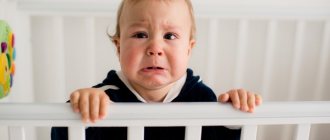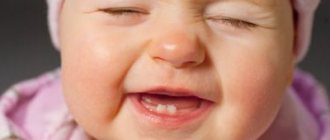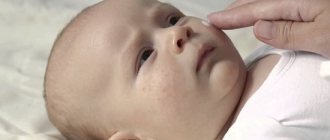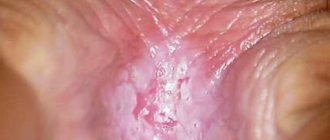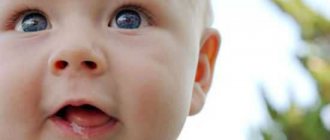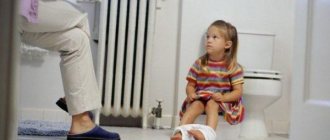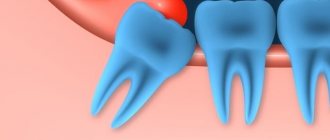In the first months of life, liquid stool is normal for babies. But sometimes there are disturbances in the functioning of the intestines, externally manifested in the form of diarrhea. Malfunctions in the gastrointestinal tract in an infant can lead to dire consequences. Therefore, it is necessary to be attentive to all unusual manifestations in the bowel movements of infants. What to do if a 3-month-old child has diarrhea?
What can diarrhea in a baby indicate?
Diarrhea may be accompanied by moodiness
We must learn to distinguish normal stool from any pathological changes. A timely reaction of parents to changes can save the health and even the life of the child. After all, failures can be evidence of serious illnesses. And simply diarrhea, which is a consequence of a disease, for example, a common acute respiratory viral infection, can quickly lead to dehydration.
What should you pay attention to?
If your baby has loose stools accompanied by vomiting, you should immediately call an ambulance. The following are cases when you should not delay calling an ambulance in case of diarrhea in a newborn:
- the child is not a year old, much less 6 months old, and has developed diarrhea (more than 3–5 cases);
- temperature above 38° C;
- the baby vomited more than 3 times;
- the child has signs of dehydration: sunken fontanel, no tears when crying, dry lips, sunken eye sockets.
You should contact your local doctor if you have the following signs of disturbances:
- mucus, foam in stool;
- a lot of gases coming out during defecation;
- diarrhea occurs often, because of this the baby is weak and does not gain weight;
- streaks of blood are noticeable in the stool;
- a rash appeared in the abdomen, on the cheeks, on the elbows and legs; the rashes have a rough surface;
- diarrhea developed after taking acetylsalicylic acid with an increase in temperature due to ARVI,
- even if several days have passed;
- diarrhea began after treatment with antibiotics for other diseases.
Possible consequences of food poisoning in children
As a rule, food poisoning, although it has clear symptoms, ends quickly and without consequences. Usually, by 3-4 days the child feels much better. In rare cases, young children may go into shock as a result of acute fluid loss. Children with severe underlying chronic pathology may develop severe inflammation.
Things are somewhat more complicated with poisoning by chemicals and poisons. If assistance is not provided in a timely manner or if there is a large amount of toxic substance, damage to the gastrointestinal tract, central nervous or cardiovascular system may persist. Their severity depends on many factors.
Botulism is a dangerous disease. According to modern literature, up to 10-20% of cases are fatal. Complications from the nervous system are common.
What should “normal” stool look like?
In the first months, infants have loose stools - this is the norm!
In the first months of life, all babies have loose stools. This is considered normal. You should not react to the advice of “well-wishers” who claim that the chair should be decorated. Perhaps such people simply don’t remember how it should be or don’t know anything, but want to seem knowledgeable on this issue.
A newborn baby cannot have formed feces; in this case, he simply would not be able to perform an act of defecation. The child cannot yet sit or stand and receives only liquid food, so he should only have loose stools. The body cannot form normal feces for an adult, because solid food particles do not enter and formed feces simply have nowhere to come from.
Therefore, parents should be calm about loose stools, which in adults is considered a deviation from the norm. There is nothing wrong with this for babies. But if the baby has hard feces, constipation will begin, which you will have to fight with your own means. After all, delayed bowel movements cause no less problems than diarrhea.
Parents need to monitor the consistency and color of stool; these indicators may change with age. Moreover, changes can occur every day. Such mobility of indicators is more common in breastfed children. Mom's diet will have a noticeable effect on the color of her stool. Therefore, even if an unfamiliar color appears, there is no need to panic; you must first analyze what the nursing woman ate. Standard indicators are given below.
First aid for food poisoning in children
First aid for moderate to severe food poisoning is gastric lavage. In children, it is better not to carry out this procedure on your own, but to seek help from specialists. Typically, washing is done with a solution of sodium bicarbonate or potassium permanganate until the wash water is clean. It is strictly forbidden to wash the stomach of children under one year of age on their own. The child may choke. Children who have been poisoned by chemicals (alkalies or acids) and plants whose juice can cause burns should not be rinsed. When they pass through the digestive tract again, in the opposite direction, they will again damage the mucous membrane.
The next step in case of food poisoning, or in a situation where it is mild, is the use of adsorbents. These are substances that collect toxins and poisons that enter the body on their surface. There are two basic rules for using such drugs. The medicine should be taken fractionally: often and in small portions. This way he will be able to collect the maximum amount of toxin. The use of the adsorbent should be short-term. No longer than 4-5 days. Long-term use of such drugs in infants leads to excessive compaction of stool and the formation of fecal impaction. Diarrhea may give way to painful constipation. A very important point in treatment is unsoldering a child, especially a small child. For infants, frequent breastfeeding and additional water are recommended. There are special solutions to replenish fluid loss. They are sold in the form of powders that are diluted with water. By consuming them, the child replenishes the loss of not only fluid, but also microelements and sugars. After 3 years, even drinking with plain water, weak tea, or compote is quite effective. According to recent clinical studies, the use of antibiotics and antiseptics for toxic infections is not effective. During the recovery period, adherence to a diet is important - eating easily digestible food in small portions. Adding vitamins and microelements.
First aid for poisoning with chemicals and poisons should be carried out by specialists. In such cases, antidotes are used.
If botulism is suspected, doctors use antitoxic serum.
How many times can there be a chair?
Diarrhea is also possible when teething
Quantity is one of the most important indicators. At first, the child may defecate up to 10 times per day. This is common in babies less than 4 months old. But there is one condition: the baby must feel good, the weight gain must be constant.
If the baby is breastfed, stool may be rare. There's nothing wrong with that. Even if the baby walks “largely” once every few days and feels good, there is no need to worry. However, you need to pay attention to the consistency of the stool; it should remain soft.
If the feces are hard, this is already a violation of the norm, which means there are digestive disorders. Diet violations made by a nursing woman can lead to this. Mom needs to monitor her diet more carefully, then everything will return to normal.
What should oral hygiene be like when teething?
Oral hygiene and caries prevention are important to reduce the likelihood of secondary infection. Brush your baby's teeth using a special napkin impregnated with xylitol and anti-inflammatory components (sold in pharmacies without a prescription). Do not give your child sweet food or drink, especially at night; Do not dip the pacifier in honey or sugar. When the first tooth emerges, visit your pediatric dentist to schedule periodic checkups [6]. Maintain a calm atmosphere in the house and carefully follow the pediatrician's instructions, this will help the child cope with teething easier.
How to identify diarrhea that requires medical attention?
Listed above are symptoms that require immediate response. As a rule, these signs indicate the development of the disease. After all, disorders associated with stool almost always indicate that one or another disease is beginning. Even otitis media in infants makes itself felt precisely through diarrhea. However, it is impossible to determine from the diarrhea what exactly happened.
Additional diagnostic tools are needed to know whether bronchitis or sinusitis is the cause of loose stools. Below are some common situations that signal the development of certain diseases.
A combination of diarrhea and fever (stool may contain mucus and blood)
Both the number of bowel movements and the frequency matter
Most likely, this is the penetration of an infection into the intestines; it can be either bacterial or viral. Symptoms may indicate that food poisoning has begun. A parasitic infection manifests itself in a similar way. In particular, giardiasis often produces exactly these symptoms.
Release forms and price category
No-spa is available in the form of tablets, as well as in ampoules for intramuscular and intravenous administration. The dosage of one tablet is 40 mg of drotaverine hydrochloride. The tablets have a yellowish-greenish color and are bitter to taste. On one side there is a marking with the inscription “spa”. There are blisters of 6 and 24 pieces. For larger quantities, bottles with stoppers are used, which have 60, 64, 100 pieces. Ampoules are available in two milliliters. The amount of drotaverine per 1 ml of solution is 20 mg; only 2 ml of solution contains 40 mg of drotaverine hydrochloride. The ampoules are made of dark glass and have a marked break point for ease of opening.
No-spa is available in the form of tablets and ampoules.
The drug is affordable. It all depends on the manufacturer, but in any case, no-silo can be classified as a budget drug.
Treatment of diarrhea in a child
Therapy consists of providing adequate oral (or, less commonly, intravenous) rehydration. Antidiarrheal drugs (for example, loperamide) are generally not recommended for children in the first year of life and early childhood. Sorbents are often prescribed. For chronic diarrhea, adequate nutrition should be maintained, especially the intake of fat-soluble vitamins. In case of illness, special methods for treating diarrhea in children are prescribed (for example, a gluten-free diet for celiac disease).
Many parents do not know what to do if their child has acute diarrhea or periodic diarrhea. In any case, you need to consult a doctor. First, you should call a pediatrician at home or use an online consultation at the RebenOK clinic. The doctor will conduct an initial examination and, if necessary, prescribe the necessary examinations. The specialist will tell you how to treat diarrhea in a child and give additional recommendations.
Causes of diarrhea in a child
The acute process is often infectious in nature, especially if it occurs suddenly or is combined with vomiting, blood, fever and anorexia. Maintenance treatment is prescribed based on clinical diagnosis and continues until improvement occurs.
Chronic diarrhea in a child without fever can develop due to the following reasons:
- Allergic gastroenteropathy. Cow's milk protein causes bloody diarrhea and vomiting. The condition is normalized when hydrolyzed protein is included in the diet instead of cow's milk. Most children improve spontaneously.
- Disaccharidase deficiency. It is characterized by the absence of lactase, which breaks down lactose into galactose and glucose. The disorder may be congenital or develop after a gastrointestinal infection, acting as a temporary disorder. An improvement in the condition after eliminating lactose or other carbohydrates from the diet confirms the diagnosis. In this case, the child has light diarrhea and there is severe irritation in the perineal area caused by liquid feces.
- Gluten enteropathy (celiac disease). In celiac disease, the wheat protein fraction damages the intestinal mucosa, which can impair fat absorption. This leads to malabsorption and anorexia, which is accompanied by the passage of copious amounts of stool. Changes in the body occur when consuming products made from wheat flour and dishes containing gluten.
- Cystic fibrosis. Cystic fibrosis is characterized by the development of pancreatic insufficiency, which is accompanied by a deficiency of trypsin and lipase. In this case, there is a large loss of fat and protein in the stool, which means that physical development is delayed. The stool is usually smelly. Children with cystic fibrosis often develop respiratory problems.
Inflammatory processes in the intestines and some infections can also cause diarrhea. The most common is gastroenteritis, an infection of the small intestine that is accompanied by vomiting. The main danger of this disease is dehydration and water-electrolyte imbalance. Dehydration develops especially often and quickly against the background of rotavirus infection.
The causes of secretory diarrhea in a child are usually due to infection:
- bacterial (staphylococcus, salmonella, E. coli, shigella);
- parasitic (giardiasis, amoebic dysentery).
Secretory diarrhea can also be caused by inflammatory bowel disease. In children it can occur with excessive consumption of carrots and peas. The reason is increased intestinal motility. This type of diarrhea goes away on its own over time. Diarrhea with blood in a child develops against the background of an acute intestinal infection - campylobacteriosis, necrotizing enterocolitis, intussusception (intestinal obstruction).
Black diarrhea
After taking activated carbon and some vitamin and mineral preparations, stool may turn black. This may also be due to internal bleeding - from the stomach, esophagus or intestines, which occurs against the background of serious pathologies (ulcers, cancer, polyps, etc.). Associated symptoms of internal bleeding may include pale complexion, dizziness and anemia.
If you have black diarrhea, you should consult a doctor immediately. For diagnosis, a specialist will prescribe fibroesophagogastroduodenoscopy (examination of the esophagus, stomach cavity and duodenum using a gastroscope, which is inserted into the stomach through the mouth and esophagus) or colonoscopy (probing of the colon).
Chronic diarrhea
Frequent diarrhea in a child can manifest itself as a mild illness or more serious disorders. At the same time, the intestinal walls become susceptible to various allergens and toxins, and the protective functions of the liver are reduced. The body absorbs vitamins and minerals worse, metabolic processes worsen, and liver and pancreas diseases occur.
The following factors can trigger the development of chronic diarrhea:
- long-term use of medications, especially antibacterial ones;
- long-term treatment with hormonal drugs and NSAIDs;
- unbalanced diet;
- immunodeficiency states;
- stress, emotional overstrain.
Chronic diarrhea causes nausea, loss of appetite, bad taste in the mouth, belching, pain and bloating, weakness and trouble sleeping. To make a diagnosis, a microbiological examination of the stool is performed, as well as an assessment of the digestive system. Therapy is aimed at eliminating the causes and restoring the general condition.
Diarrhea with mucus
Mucous diarrhea in a child develops against the background of a violation of the intestinal microflora, polyps and hemorrhoids. Mucus binds and removes pathogenic microorganisms. Clinical signs of hemorrhoids include itching and bleeding from the anus. Intestinal diverticulitis also causes mucus to be secreted in the feces. Associated symptoms are abdominal pain arising on the left side and flatulence.
Diarrhea with mucus in children occurs as a result of insufficient bowel function. As a rule, this is associated with poor nutrition. This condition is accompanied by malaise, nausea and rumbling in the stomach. Liquid feces with mucus also occur with IBS (irritable bowel syndrome). To identify the disease and the purpose of therapy, you need to contact a specialist and conduct a diagnosis.
Diarrhea and fever
Diarrhea, vomiting and fever are the main signs of an intestinal infection, which can be caused by bacteria or viruses. An accurate diagnosis can only be made by a doctor after examination.
In the first hours after the onset of alarming symptoms, frequent small drinks are necessary. Dark colored urine may indicate a lack of fluid in the body. Normalizing the water-salt balance during intestinal infections is extremely important. Refusal of food and heavy drinks in case of diarrhea, vomiting and fever is a necessary condition. Drug treatment of intestinal infections is carried out under the strict supervision of a doctor.
Severe diarrhea
If the small intestine is affected, severe diarrhea may occur. This can happen during food poisoning and intestinal infections. Often such stools are watery, may contain food debris and do not cause abdominal pain. Bile acids and peptide molecules can promote the release of water and ions. The severe condition can occur when the absorption of bile and fatty acids is impaired, such as in Crohn's disease.

